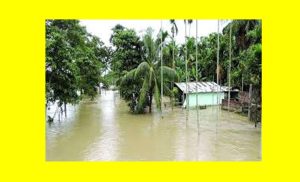“Explore the causes, effects, and control measures of floods in Assam in this comprehensive article ‘Floods in Assam Essay’ Explore the causes, effects, and control measures of floods in Assam in this comprehensive essay.
Floods in Assam Essay
Or
Great Flood in Assam
Introduction:
Assam, a state located in northeastern India, is known for its scenic beauty and rich biodiversity. However, it is also infamous for its recurring problem of floods. The state experiences annual inundations, wreaking havoc on the lives and livelihoods of its residents. This essay discusses the causes, consequences, and measures to mitigate the devastating impact of floods in Assam.
Causes of Floods in Assam:
Monsoonal Rainfall: The primary cause of floods in Assam is the heavy monsoonal rainfall. The state receives a significant amount of precipitation during the monsoon season, primarily from June to September. This rainfall, combined with the region’s unique topography, leads to extensive flooding.
Brahmaputra River: Assam is traversed by the mighty Brahmaputra River, one of the world’s largest rivers. During the monsoon, the river often overflows its banks, causing widespread inundation. The river carries silt, which raises the riverbed, making it prone to overflowing.
Geographical Vulnerability: Assam’s geographical location and terrain exacerbate the flooding problem. The state is characterized by numerous rivers, lakes, and wetlands. Additionally, the presence of hills and mountains to the north further directs water flow towards the plains, increasing the risk of floods.
Consequences of Floods in Assam:
Loss of Lives: Floods in Assam often result in the loss of human lives. People are caught off guard, and those in low-lying areas are particularly vulnerable to drowning and other water-related accidents.
Displacement: Floods displace a significant number of people each year. Families are forced to evacuate their homes, seeking shelter in relief camps or with relatives. These displacements disrupt education, employment, and daily life.
Agricultural Loss: Assam’s economy is heavily dependent on agriculture. Floods cause extensive damage to crops, leading to reduced yields and food shortages. The loss of livestock further compounds the agricultural crisis.
Infrastructure Damage: Floods damage roads, bridges, and other critical infrastructure, hampering transportation and communication networks. This, in turn, affects relief and rescue operations.
Environmental Impact: The rich biodiversity of Assam is also affected by floods. Wildlife is displaced, and vital habitats are destroyed. Pollution of water sources can have long-term effects on the environment.
Measures to Mitigate Floods in Assam:
Early Warning Systems: The government should invest in advanced early warning systems to provide timely alerts to residents in flood-prone areas. This can help them evacuate and prepare for the impending disaster.
Riverbank Protection: Strengthening and reinforcing riverbanks can help prevent river erosion and control flooding. Dams and embankments need regular maintenance and upgrades.
Sustainable Urban Planning: Urban development must account for the flood-prone nature of the region. Building codes and land-use planning should focus on resilience and flood control.
Reforestation: Promoting reforestation in the hills and mountains surrounding Assam can help in retaining rainwater and reducing the speed of water flow into the plains.
Community Awareness: Public awareness campaigns should educate residents about flood preparedness, evacuation plans, and safety measures.
Conclusion:
Floods in Assam are a recurring and devastating natural calamity. Efforts to mitigate their impact require a multi-pronged approach, including improved infrastructure, early warning systems, and community involvement. With a concerted effort from the government, environmental organizations, and the people of Assam, it is possible to reduce the damage caused by these annual floods and build a more resilient state that can better withstand this formidable natural challenge.0 0 0.
You Might Like:
- Ready Guide Seba English IX
- Ready Guide Seba English X
- Ready Guide HS 1st Yr English
- Ready Guide HS 2nd Yr English
Note: Our Ready Guides contain textual and important additional questions and answers written by experienced teachers. Our language is easy and simple to understand and remember.
Floods in Assam Essay (2)
Flood in Assam: Causes, Effects, Measures to Control
Introduction
Assam, located in the northeastern part of India, is known for its rich biodiversity, lush green landscapes, and the mighty Brahmaputra River. However, it is also infamous for the recurring floods that devastate the state almost every year. Floods in Assam have become a persistent problem, causing extensive damage to life, property, agriculture, and the overall economy. This essay explores the causes, effects, and control measures of floods in Assam, along with relevant data to understand the severity of this natural disaster.
Causes of Floods in Assam
Heavy Rainfall: Assam experiences heavy monsoons from June to September. The state receives an average annual rainfall of about 2,500 mm. The intense and prolonged rainfall leads to a rapid rise in water levels in rivers, especially the Brahmaputra and its tributaries, causing them to overflow and flood the surrounding areas.
Overflow of Rivers: The Brahmaputra River, one of the largest rivers in the world, flows through Assam and is the primary cause of floods in the region. The river, along with its numerous tributaries like the Barak, Subansiri, and Manas, swells during the monsoon season, inundating nearby areas.
Erosion of Riverbanks: The Brahmaputra River is notorious for its high rate of erosion. Riverbank erosion not only displaces communities but also weakens the natural embankments, making areas more susceptible to flooding.
Sedimentation: The rivers in Assam carry a heavy load of silt and sediments from the Himalayas. Over time, these sediments accumulate on the riverbeds, raising their levels and reducing the water-holding capacity, which exacerbates flooding.
Deforestation: Uncontrolled deforestation in the catchment areas for agriculture, urbanization, and industrial purposes reduces the natural absorption of rainwater by the soil, leading to increased surface runoff and flooding.
Climate Change: Changes in global climate patterns have led to erratic rainfall and extreme weather events. The frequency and intensity of rainfall have increased, contributing to severe flooding in Assam.
Poor Drainage Systems: Urban areas in Assam, particularly Guwahati, suffer from poor drainage systems. During heavy rains, these inadequate drainage systems fail to channel water efficiently, leading to urban flooding.
Effects of Floods in Assam
Loss of Life and Property: Floods cause widespread destruction, leading to the loss of human lives, livestock, and homes. Every year, hundreds of people are displaced, and many lose their lives due to drowning, landslides, or electrocution.
Damage to Agriculture: Agriculture is the backbone of Assam’s economy, and floods have a devastating impact on this sector. Crops such as rice, tea, and vegetables are often submerged, leading to massive financial losses for farmers and food shortages.
Impact on Infrastructure: Floods severely damage infrastructure, including roads, bridges, railways, and buildings. The repair and reconstruction of these structures require significant financial resources and time, disrupting the lives of residents.
Erosion and Displacement: Riverbank erosion, a byproduct of flooding, leads to the loss of land and homes. This displacement forces people to relocate, often to makeshift camps with poor living conditions, lacking access to basic amenities.
Health Issues: Floods result in the contamination of drinking water sources, leading to outbreaks of waterborne diseases like cholera, dysentery, and typhoid. Stagnant water also becomes a breeding ground for mosquitoes, increasing the risk of diseases such as malaria and dengue.
Impact on Wildlife: Assam is home to several wildlife sanctuaries and national parks, including Kaziranga National Park, which hosts the largest population of one-horned rhinoceroses. Floods disrupt the natural habitat of wildlife, leading to animal deaths, habitat destruction, and increased human-wildlife conflict.
Measures to Control Floods in Assam
Construction of Embankments and Dams: Strengthening and maintaining embankments along the Brahmaputra and its tributaries is crucial in preventing floods. Additionally, the construction of multipurpose dams can help regulate river flow, store excess water, and generate hydroelectric power.
River Dredging: Regular dredging of riverbeds is necessary to remove accumulated silt and sediments. This increases the water-carrying capacity of the rivers and reduces the likelihood of flooding.
Afforestation and Soil Conservation: Planting trees along riverbanks and in catchment areas helps reduce soil erosion and increases the absorption of rainwater. This natural solution can significantly mitigate the severity of floods.
Improving Drainage Systems: Upgrading urban drainage systems, especially in flood-prone cities like Guwahati, is essential for managing heavy rainfall and preventing urban flooding.
Flood Forecasting and Early Warning Systems: The establishment of advanced flood forecasting and early warning systems can help reduce the impact of floods. Timely alerts allow people to evacuate to safer areas and take necessary precautions to protect life and property.
Integrated Water Resources Management: Implementing integrated water resources management (IWRM) practices can help in the sustainable management of water resources, including flood control, irrigation, and drinking water supply.
Community Awareness and Preparedness: Educating communities about flood risks and preparedness measures is vital. Training programs on emergency response, evacuation plans, and first aid can empower local populations to respond effectively during floods.
Statistical Data on Floods in Assam
- Annual Floods: Assam experiences floods almost every year. In 2022, over 3 million people were affected, with thousands displaced from their homes.
- Economic Losses: The economic losses due to floods in Assam are immense, with damages to property, infrastructure, and crops amounting to billions of rupees each year.
- Land Erosion: The Brahmaputra River erodes approximately 8,000 hectares of land annually, leading to the displacement of thousands of people.
Conclusion
Floods in Assam are a recurring natural disaster with severe consequences for the state’s people, economy, and environment. While natural factors like heavy rainfall and river overflow contribute to the problem, human activities such as deforestation and poor urban planning exacerbate the situation. Effective flood management requires a combination of structural measures, such as embankments and dredging, along with non-structural approaches like early warning systems, community preparedness, and afforestation. With concerted efforts from the government, communities, and other stakeholders, it is possible to mitigate the impact of floods and protect the lives and livelihoods of the people of Assam. 0 0 0
Floods in Assam Essay
You May Like:
Additional Searches:







